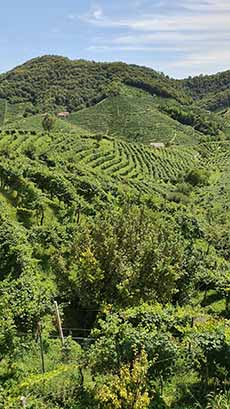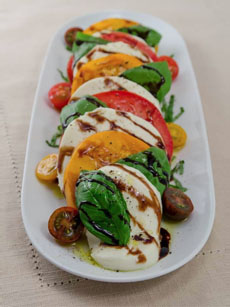Prosecco & Prosecco Rose Wine For National Prosecco Day
|
|
August 13th is National Prosecco Day, celebrating Italy’s most famous sparkling wine from Italy (the next best-known is Asti Spumante). See the different types of sparkling wine below. With lively bubbles and nuances of fruit, Prosecco is also affordable, with bottles from just $7. You can enjoy it every day! While lovely bottles cost around $15, there are highly-rated labels that are pricey because of supply and demand—up to $50 and more (here’s more about them). In the summer, Prosecco’s medium-light body is perfect for an apéritif, to serve with lunch and dinner, for a break, and as a patio-and-pool refresher. > The history of Prosecco. Prosecco is named after the former village of Prosecco in northeast Italy, where it was first produced. The village is now part of the city of Trieste, a port city on the Adriatic that’s the capital city of the Friuli Venezia Giulia region. By E.U. law, Prosecco D.O.C. can be produced exclusively produced in a limited area around where it began: nine provinces in two Italian regions, Veneto (the main producing region) and Friuli-Venezia Giulia. It’s a beautiful area, lying between the Dolomite mountains and the Adriatic Sea. Also by law, Prosecco must be made from at least 85% Glera grapes, a white grape of Slovenian origin, which was brought to the village of Prosecco long ago from the Karst Plateau region, which extends across the border of southwestern Slovenia and northeastern Italy. While some Prosecco producers do make 100% Glera wines, many blend in varieties such as Chardonnay, Pinot Bianco, Pinot Grigio, Pinot Nero, or more obscure local grapes such as Bianchetta Trevigiana, Glera Lunga, Perera or Verdiso. Some researchers believe that the glera grape was cultivated in Roman times, and may have been the vinum pucinum praised by Pliny the Elder, which was produced “in the gulf of the Adriatic Sea” [source]. Today, the grape ranks about 30th among the country’s some 2,000 grape varieties [source]. All Prosecco wines enjoy D.O.C. status, short for Denominazione di Origine Controllata, “controlled designation of origin.” This protected geographic designation signifies authentic Prosecco. No other wine can use the name. The names Prosecco D.O.C. Treviso and Prosecco D.O.C. Trieste can also be used, but only if 100% of the grape harvest, winemaking, and bottling take place within the provinces of Treviso or Trieste, respectively. Prosecco Rosé was made an official D.O.C. in 2020 and is expected to account for 10% of the half-million bottles of Prosecco produced this year. While all Prosecco wines are D.O.C., there’s a premium level called D.O.C.G., the “G” for “garantita,” guaranteed. That’s a guarantee, designated by the Italian government, that the wines are of especially high quality. Prosecco DOCG refers to two approved Prosecco wines: those from the Conegliano-Valdobbiadene area, and those from the Asolo area. Both zones are located in the Italian region of Veneto. As Prosecco became an enormously popular sparkling wine in the 1980s and 1990s, officials in Italy wanted to separate the traditional zones in Veneto from other areas where Prosecco was being produced (the neighboring region of Friuli, for example). Thus the DOCG stamp of approval was granted to Prosecco from Conegliano-Valdobbiadene in the northern Venetian province of Treviso. This is “the heart and soul of Prosecco,” and most of the finest wines come from this hilly area. A second DOCG was granted to the Prosecco of the Asolo area, also in Veneto but farther south and west. Known as Asolo Prosecco DOCG (or Colli Asolani Prosecco DOCG), this is an area near the Venetian Alps. Plantings here reach as high as 1500 feet above sea level. The thinking was that by creating separate DOCG zones, consumers would know that the finest examples of Prosecco are DOCG and not DOC. This is generally true; however, having two DOCG areas has certainly created some confusion [source]. And no matter, there are some absolutely splendid D.O.C. wines. Don’t hesitate to try them. The Guinigi Prosecco Rosé was a treat drink, and we look forward to having more. We may even try a bottle of Guigini’s regular (white) Prosecco, although our palate tends to prefer Prosecco Rosé. The 2020 vintage ($17)has a clean, refreshing profile: bright and delicate, with a soft hue and fine, lasting bubbles. The nose has notes of apple, white peach, citrus, and wild strawberries balanced against floral notes of peach blossoms. The mouthfeel is refreshing. with a high level of acidity cleansing the palate between each new sip. The wine was crafted from a blend of Glera and Pinot Noir grapes, harvested in mid-September. The Glera grapes come mainly from the hilly province of Treviso, the Pinot Noir grapes from Friuli. While you can enjoy the Prosecco Rosé with many foods, As an apéritif or a wine throughout a meal of lighter dishes, Guinigi suggests these specific food pairings: The name “Guinigi” and the label art are inspired by la Torre Guinigi, a historical landmark in the town of Lucca, Tuscany, where ancestors of the Sebastiani family resided. A typical example of local Romanesque-Gothic architecture, the tower is 45 meters (148 feet) high, with a total of 232 steps to reach the top. It is one of the few towers of its era still standing in Italy. Discover more at GuinginiWines.com. The most famous sparkling wine—and the far most expensive—is Champagne from France. Consider these more affordable bubblies at half the price or less: England is not known as a producer of wine. However, they have had success in producing sparkling wines, using the same grapes as Champagne (primarily, Pinot Noir and Chardonnay). Five years ago, the first sparkling wines from England came onto the market. While there is not yet an official name for them, some in the English wine business suggest Britagne, pronounced Britannia or more precisely, bri-TAN-yuh, to rhyme with the French pronouncing of Champagne, shom-PAN-yuh. Here’s more about English sparkling wines. |
|
|
|
||






